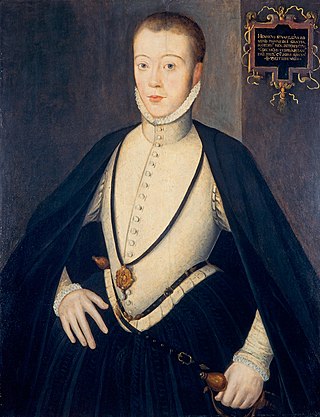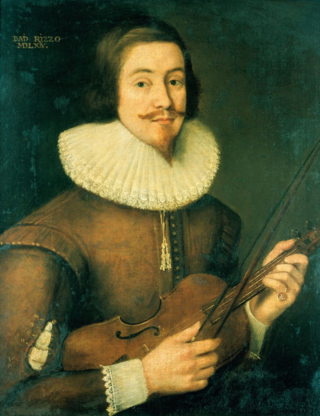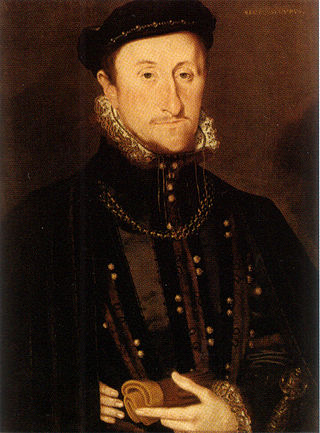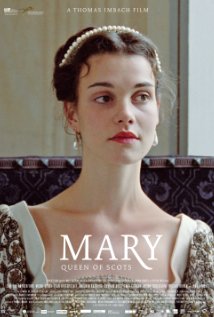
Mary, Queen of Scots, also known as Mary Stuart or Mary I of Scotland, was Queen of Scotland from 14 December 1542 until her forced abdication in 1567.

Henry Stuart, Lord Darnley, was the second husband of Mary, Queen of Scots, and the father of James VI of Scotland and I of England. Through his parents, he had claims to both the Scottish and English thrones, and from his marriage in 1565 he was king consort of Scotland. Less than a year after the birth of his son, Darnley was murdered at Kirk o' Field in 1567. Many contemporary narratives describing his life and death refer to him as simply Lord Darnley, his title as heir apparent to the Earldom of Lennox.

David Rizzio or Riccio was an Italian courtier, born in Pancalieri close to Turin, a descendant of an ancient and noble family still living in Piedmont, the Riccio Counts di San Paolo e Solbrito, who rose to become the private secretary of Mary, Queen of Scots. Mary's husband, Lord Darnley, is said to have been jealous of their friendship because of rumours that Rizzio had impregnated Mary, and he joined in a conspiracy of Protestant nobles to murder him, led by Patrick Ruthven, 3rd Lord Ruthven. Mary was having dinner with Rizzio and a few ladies-in-waiting when Darnley joined them, accused his wife of adultery and then had a group murder Rizzio, who was hiding behind Mary. Mary was held at gunpoint and Rizzio was stabbed numerous times. His body took 57 dagger wounds. The murder was the catalyst of the downfall of Darnley, and had serious consequences for Mary's subsequent reign.
James Balfour, Lord Pittendreich (c. 1525–1583) was a Scottish legal writer, judge and politician.

Mary, Queen of Scots is a 1971 biographical film based on the life of Mary Stuart, Queen of Scotland, written by John Hale and directed by Charles Jarrott. The cast was led by Vanessa Redgrave as the title character and Glenda Jackson as Elizabeth I. Jackson had previously played the part of Elizabeth in the BBC TV drama Elizabeth R, screened in February and March 1971, the first episode of which was also written by Hale.
Archibald Campbell, 5th Earl of Argyll was a Scottish nobleman, peer, and politician. He was one of the leading figures in the politics of Scotland during the reign of Mary, Queen of Scots, and the early part of that of James VI.

James Stewart, 1st Earl of Moray was a member of the House of Stewart as the illegitimate son of King James V of Scotland. At times a supporter of his half-sister Mary, Queen of Scots, he was the regent of Scotland for his half-nephew, the infant King James VI, from 1567 until his assassination in 1570. He was the first head of government to be assassinated with a firearm.

The Chaseabout Raid was a rebellion by James Stewart, 1st Earl of Moray, against his half sister, Mary, Queen of Scots, on 26 August 1565, over her marriage to Henry Stuart, Lord Darnley. The rebels also claimed to be acting over other causes including bad governance, and religion in the name of the Scottish Reformation. As the government and rebel forces moved back and forth across Scotland without fighting, the conflict became known as the "chase about raid." Queen Mary's forces were superior and the rebel lords fled to England where Queen Elizabeth censured the leader.
Gunpowder, Treason & Plot is a 2004 BBC miniseries based upon the lives of Mary, Queen of Scots and her son James VI of Scotland. Written by Jimmy McGovern, the series tells the story behind the Gunpowder Plot in two parts, each centred on one of the respective monarchs. The first film dramatizes the relationship between Mary and her third husband, James Hepburn, 4th Earl of Bothwell. Scottish actor Robert Carlyle stars as James VI in the second part, which concentrates on the Gunpowder Plot, planned by Guy Fawkes, to blow up the Houses of Parliament in order to rid the nation of a Protestant monarch.

The murder of Henry Stuart, Lord Darnley, second husband of Mary, Queen of Scots, took place on 10 February 1567 in Edinburgh, Scotland. Darnley's lodgings were destroyed by gunpowder; his body and that of his servant were found nearby, apparently having been strangled rather than killed in the explosion. Suspicion was placed upon Queen Mary and the Earl of Bothwell, whom Mary went on to marry three months after Darnley's murder. Bothwell was indicted for treason and acquitted, but six of his servants and acquaintances were subsequently arrested, tried, and executed for the crime.
The Battle of Carberry Hill took place on 15 June 1567, near Musselburgh, East Lothian, a few miles east of Edinburgh, Scotland. A number of Scottish lords objected to the rule of Mary, Queen of Scots, after she had married the Earl of Bothwell, who was widely believed to have murdered her previous husband Lord Darnley. The Lords were intent to avenge Darnley's death. However, Bothwell escaped from the stand-off at Carberry while Queen Mary surrendered. Mary abdicated, escaped from prison, and was defeated at the battle of Langside. She went to exile in England while her supporters continued a civil war in Scotland.
Anna Tronds, known in English as Anna Throndsen and posthumously as Anna Rustung, was a Dano-Norwegian noblewoman. In English and Scots history, Anna Throndsen is best known for her marriage to James Hepburn, 4th Earl of Bothwell, a man who later married Mary, Queen of Scots. Anna Throndsen is also known for her possible but much debated and disputed involvement in drafting some of the famous Casket Letters; these letters being the principal evidence against Mary.

Jean Hepburn, Lady Darnley, Mistress of Caithness, Lady Morham was a Scottish noblewoman and a member of the Border clan of Hepburn. Her brother was James Hepburn, Earl of Bothwell, the third husband of Mary, Queen of Scots. Jean's first husband was John Stewart, 1st Lord Darnley, an illegitimate half-brother of Queen Mary, which made Jean a double sister-in-law of the queen. Jean married three times. She was also Lady of Morham, having received in 1573 the barony of Morham and lands which had belonged to her mother, Lady Agnes Sinclair and was forfeited to the Crown subsequent to her brother, the Earl of Bothwell's attainder for treason.
Das Herz der Königin is a 1940 German historical film, making selective use of the life story of Mary, Queen of Scots, and her execution by Queen Elizabeth I for anti-English and pro-Scottish propaganda, in the context of the Second World War going on at the time.

The Loves of Mary, Queen of Scots is a 1923 British silent historical film directed by Denison Clift and starring Fay Compton, Gerald Ames and Ivan Samson. The film depicts the life of Mary, Queen of Scots, and her eventual execution. It was one of the final films made by Ideal, one of the leading British studios, before they were hit by the Slump of 1924.
John Spens, Lord Condie (1520?–1573) was a Scottish lawyer and judge who became Lord Advocate.

Mary Queen of Scots is a 2013 Swiss period drama directed and co-written by Thomas Imbach. It is his first film in the English and French languages, starring the bilingual French actress Camille Rutherford. The film portrays the inner life of Mary, the Queen of Scotland. The film is based on the Austrian novelist Stefan Zweig's 1935 biography, Mary Stuart, a long-term bestseller in Germany and France but out of print in the UK and the US for decades until 2010. The film was first screened at the 2013 International Film Festival Locarno and was later shown at the 2013 Toronto International Film Festival.
Mary of Scotland was a 1933 Broadway three-act play written in blank verse by Maxwell Anderson, produced by the Theatre Guild, directed by Theresa Helburn and with scenic and costume design by Robert Edmond Jones. It ran for 248 performances from November 27, 1933 to July 1934 at the Alvin Theatre. A scene between Mary and Elizabeth never actually happened as they never met. Anderson's son Quentin Anderson played a warder. It was included in Burns Mantle's The Best Plays of 1933-1934.

Mary Queen of Scots is a 2018 historical drama film directed by Josie Rourke and with a screenplay by Beau Willimon based on John Guy's 2004 biography Queen of Scots: The True Life of Mary Stuart. The film stars Saoirse Ronan as Mary, Queen of Scots, and Margot Robbie as her cousin Queen Elizabeth I. Jack Lowden, Joe Alwyn, David Tennant, and Guy Pearce also star in supporting roles.

Mary, Queen of Scots, and Henry Stuart, Lord Darnley, were married at the Palace of Holyroodhouse on 29 July 1565, when she was 22 years old, and he was 19.













